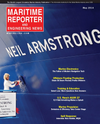
Page 44: of Maritime Reporter Magazine (May 2014)
Marine Electronics Edition
Read this page in Pdf, Flash or Html5 edition of May 2014 Maritime Reporter Magazine
44 Maritime Reporter & Engineering News • MAY 2014
Q
Representing “Class” James Watson, President &
COO, Americas Division, ABS Philippe Donche-Gay, Execu- tive Vice president and Head of the Marine and Offshore Division,
Bureau Veritas Noboru Ueda, Chairman &
President, ClassNK Paal Johansen, Head of the
Americas Region for DNV GL –
Maritime Tim Protheroe, President,
Lloyd’s Register North America,
Inc. Roberto P. Cazzulo, RINA Paal Johansen, DNV GL
The stricter environmental regulations and rising fuel costs lead to technology development in design, size, propulsion and operations. This goes well beyond
LNG as fuel, and we believe we will see a more diversifi ed mix, with batteries, hybrids, methanol and so on. James Watson, ABS
The traditional focus on class has been on certifying the safety of steel struc- tures. Today, with the increasing em- phasis on safety from the environmental perspective, the focus has shifted from structures to systems, looking at optimi- zation of the hull form and of the equip- ment onboard.
Traditional physical model testing re- mains an essential component of hull form development, but analytical tech- niques, such as Computational Fluid
Dynamics (CFD), have come into their own software able to handle the complex calculations required.
Arriving at the most effi cient vessel requires looking at the hull and the as- sociated appendages – propeller, rudder, energy saving devices, bulbous bow (or no bulb) – as a complete and integrated system.
This also extends inside the ship to the type of central power plant, effi ciency of onboard systems and energy man- agement, fuel choices and measures to reduce consumption, compliance with emission standards for SOX and NOx, ballast water and underwater noise.
This is increasingly facilitated through technologies utilized onboard to moni- tor, record and assess performance. ABS is continuing to improve its products and services to enable an expanding scope of transparent sharing of performance data between the owner and class to assist in this process.
This sharing of data is also laying the path for a shift in the near future, away from traditional prescriptive require- ments towards more risk-based classifi - cation activities, such as annual surveys.
This will be made possible by class and industry working closely together to share information and have a better un- derstanding of performance of both ship structures and the associated onboard systems. Noboru Ueda, ClassNK
Without a doubt, the biggest change
MARINE POWER REPORT
Marine Propulsion
When talk turns to ma- rine propulsion and the host of surrounding top- ics – emissions, effi ciency, fuel consumption – we turn to class for answers.
While there are just two questions, the ensuing answers from leaders at
ABS, BV, ClassNK, DNV
GL, LR and RINA are vo- luminous & enlightening.
By Greg Trauthwein
As the industry has been faced with simultaneous regulatory & market pressures over the past five years, what do you con- sider to be the most influential changes to the vessel and why?
Watson
Donche-Gay
Ueda
Johansen Protheroe Cazzulo
MR #5 (42-49).indd 44 5/1/2014 12:04:08 PM

 43
43

 45
45
